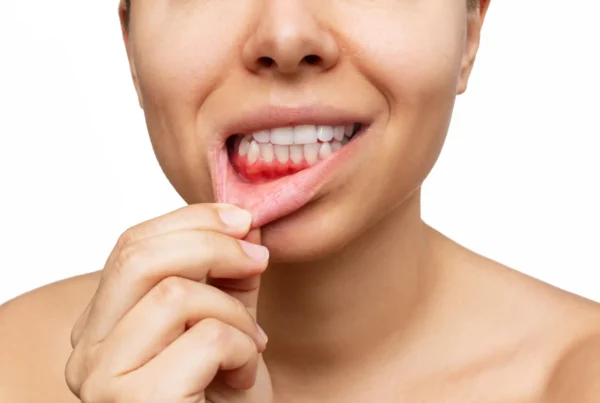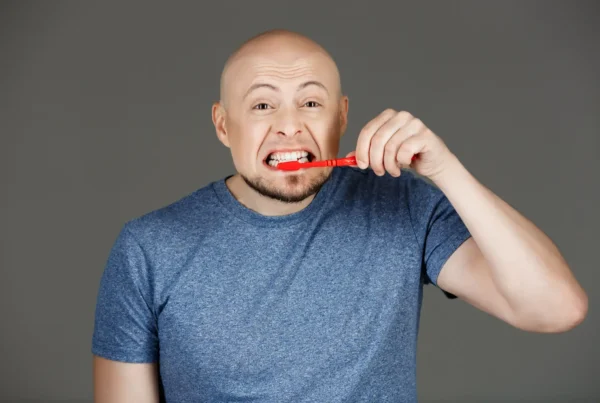- What are exposed tooth necks?
- How to brush your teeth with exposed tooth necks
- How to choose the best toothbrush: sonic, manual, or electric?
- What to look for in a toothbrush: which bristle type is best?
- Care tips for exposed tooth necks: what brushing method to follow
- What to avoid when dealing with exposed tooth necks
- Oral hygiene with gum recession: summary

Exposed tooth necks can lead to sensitivity, pain during eating or drinking, and an increased risk of cavities. This condition is often caused by gum recession, where the gum tissue that normally protects the roots of the teeth starts to pull back. The most common causes include improper oral hygiene, aggressive brushing, malocclusion, tartar buildup, and gum diseases such as periodontitis. To ease discomfort and prevent further damage, proper brushing techniques and the right toothbrush are essential.
What are exposed tooth necks?
Exposed tooth necks occur when the gums recede and reveal the sensitive part of the tooth located between the crown and the root. In a healthy mouth, this area is covered by gum tissue, which acts as a natural barrier against external factors. When this protection disappears, it can result in sensitivity, a higher risk of infection, and in severe cases, even tooth loss.
One of the most noticeable symptoms is tooth sensitivity, experienced as pain or discomfort when consuming hot, cold, sweet, or acidic foods and drinks. In some cases, bleeding may occur during brushing or flossing. Teeth may also appear longer than before due to the receding gums exposing more of the tooth root.
How to brush your teeth with exposed tooth necks
Gentle brushing technique
Use the Bass technique to clean along the gum line effectively and without irritation. Place the toothbrush at a 45-degree angle towards the gum line so the bristles gently reach the spaces between the teeth and gums. Make short, sweeping motions along the teeth and avoid scrubbing, which can worsen gum recession. It’s also important not to apply too much pressure, as this can damage the enamel and increase the risk of further exposure. Toothbrushes with pressure sensors, available in some electric and sonic models, can help monitor brushing force and protect the gums.
Choosing the right toothbrush
A soft or ultra-soft toothbrush is the best option for brushing teeth with exposed necks. Sonic toothbrushes with gentle cleaning modes are highly recommended, as they offer effective plaque removal while minimizing the risk of irritation. If you prefer a manual toothbrush, look for one with rounded bristle tips, which are gentler on both gums and tooth necks. Using a soft-bristled toothbrush is essential, as more and more people are experiencing this issue.
Brushing frequency and duration
Teeth should be brushed twice daily for around two minutes. Focus on precision and gentleness rather than intensity. Brushing for longer or with more force may have the opposite effect and cause additional irritation.
Complementing hygiene with other tools
In addition to brushing, consider using dental floss or a water flosser to clean between the teeth. Water flossers with adjustable pressure settings are especially helpful, as they gently remove debris without irritating sensitive areas.
How to choose the best toothbrush: sonic, manual, or electric?
Selecting the right toothbrush is key to protecting exposed tooth necks and delicate gum tissue. Choose one that cleans thoroughly while minimizing the risk of irritation or damage. Below are the most suitable toothbrush types for sensitive teeth and gums.
Manual toothbrushes
Manual toothbrushes with soft or ultra-soft bristles are a standard recommendation for people with exposed necks. The soft bristles remove plaque without harming the gums or exposed dentin. Rounded bristle tips offer additional protection for sensitive areas.
Sonic toothbrushes
Sonic toothbrushes are an excellent option because they use gentle vibrations to remove plaque effectively without aggressive scrubbing. The bristles do most of the work, making cleaning easier and more pleasant. Models with adjustable intensity settings can be adapted to sensitive teeth. Sensitive brush heads provide comfort and safety for daily use.
Electric rotating-oscillating toothbrushes
These toothbrushes may also be suitable, but it’s important to choose one with a pressure sensor. This function prevents excessive force on the tooth surface, which is especially important when the necks are exposed. Models offering gentle cleaning modes further reduce the risk of irritation.
Single-tuft toothbrushes
For precise cleaning along the gum line and in hard-to-reach areas, single-tuft toothbrushes are ideal. Their small heads and concentrated bristles ensure thorough yet gentle plaque removal without damaging the gums.
What to look for in a toothbrush: which bristle type is best?
Choose soft or ultra-soft bristles to avoid irritating the gums. A smaller brush head allows for more accurate cleaning in delicate areas. Features like adjustable vibration intensity in sonic models or pressure sensors in electric ones help prevent excessive force. High-quality toothbrushes from reputable manufacturers, especially those recommended by dentists, are always a safe choice.
Care tips for exposed tooth necks: what brushing method to follow
Proper care of exposed tooth necks is essential to reduce sensitivity, prevent further gum recession, and protect vulnerable dentin. Here are key guidelines for maintaining oral hygiene with this condition.
Use a toothbrush with soft or ultra-soft bristles that cleans gently without causing irritation. Brush your teeth with the Bass technique—position the toothbrush at a 45-degree angle to the gum line and make short, sweeping motions. Avoid intense scrubbing and pressing too hard, as both can contribute to further gum recession.
Use toothpaste designed for sensitive teeth, containing ingredients like sodium fluoride or arginine that help soothe discomfort. Mild mouthwashes can also aid in gum regeneration and protect the dentin. When using a water flosser, set it to low pressure to gently clean interdental areas without irritating exposed necks.
What to avoid when dealing with exposed tooth necks
Avoid hard-bristled toothbrushes, as they can worsen irritation and damage exposed dentin. Refrain from aggressive brushing, which can accelerate gum recession and tooth root exposure. Instead, opt for a sonic toothbrush, which is gentle and safe while providing excellent cleaning results. Steer clear of high-abrasive toothpastes, such as whitening formulas, which can erode the sensitive surface of the dentin. Don’t skip regular dental visits, as professional monitoring and guidance are vital for managing gum issues and exposed necks.
Oral hygiene with gum recession: summary
Incorrect brushing techniques, tobacco use, aggressive whitening, and improper oral hygiene tools all contribute to gum recession and exposed tooth necks. These issues are often accompanied by inflammation, periodontal disease, and problems where teeth meet the gums. Using a soft-bristled toothbrush, maintaining consistent brushing habits (at least twice daily), and removing plaque buildup are the foundations of good oral hygiene.
Remember to use products formulated for sensitivity and visit your dentist regularly to tailor your care routine to your needs. With the right hygiene practices, you can effectively minimize complications and support healthy teeth and gums. For those struggling with exposed tooth necks, we offer a dedicated selection of products in our online store to help you care for your oral health in the best possible way.





